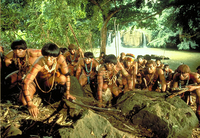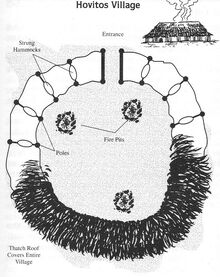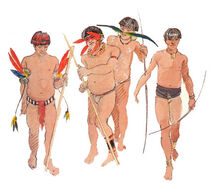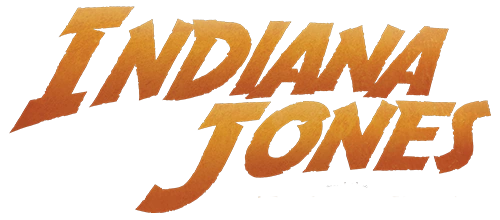- "If they knew we were here, they would've killed us already."
- ―Barranca, on the Hovitos[src]

The Hovitos tribe.
The Hovitos, also known as Hovitos Indians, Hovito, or the Chachapoyan Tribe, were the descendants of the Chachapoyans that had hidden their fertility idol inside a Peruvian temple.
The Hovitos tribe lived in the mountainous jungles of Peru, and had their own language. Hovitos warriors armed themselves with blowguns equipped with poison-tipped darts in addition to spears and bow and arrows when hunting and fighting.
History
By the 20th century, the Chachapoyans were long gone from the world,[1] but their lineage survived in successor peoples such as the Hovitos,[2] and the group from whom Xomec was a descendant.[3] Both were sometimes referred to as Chachapoyans themselves.[3][4]
Within the vicinity of the millenia-old Temple of the Chachapoyan Warriors,[5] located in a secluded valley in the jungle highlands of Chachapoyas, Peru,[2][4] the Hovitos developed a hunter-gatherer society led by a chieftain: the women would peen and cook plantains, roots and plants from the rainforest in addition to the monkey, fish, alligator and deer meat brought back by the men. Their community was built around the prestige of their hunters and warriors but they also held reverence for shamans and witch doctors who induced visions and practised medicine with a variety of substances.[2]
In 1893, Bandelier mapped the region, following in the footsteps of Juan Crisostomo Nieto's expedition fifty years earlier, and noted the presence of a "head hunter village."[6] If this was a Hovitos village, he may not have been aware that their settlements were impermanent, shifting location between fresh water sources on an almost annual basis to evade rival tribes and take advantage of new hunting grounds.[2]

A Hovitos village was a singular, wheel-shaped structure built from wood and possessed just one entrance/exit. A thatched roof covered the village with the exception of the central courtyard holding several stone-lined fire pits for cooking. The Hovitos slept in hammocks strung up between the support poles of the roof which were protected by a wooden stockade that circled the perimeter.[2]
Despite their seminomadic nature, the tribe was fiercely territorial, lethally so in the case of intrusion on land that they considered sacred such as the Chachapoyan Temple valley where their warriors' weekslong manhood rituals took place. War against other Hovitos villages were infrequent and usually provoked by other factors such as the accidental death of a chieftain, overhunting in the area or clashes with other hunting parties over game.[2]
The secluded Hovitos had had contact with Westerners in their past. Missionaries brought with them metal pots and utensils, while the occasional explorer had exchanged "shiny trinkets" in exchange for Hovitos guides to the rainforest but the Hovitos were wary of technology that they couldn't comprehend like firearms and electricals. At some point they came to usually expect gifts in return for their hospitality. However, village temperament was often dependent on their situation at the time. A flourishing village may have celebrated visitors with feasting but in times of war or when experiencing a famine, the Hovitos would treat outsiders as warmongerers or food thieves.[2]
Toward the end of the 19th century, rumors of an unspoiled Chachapoyan site began to pique archaeological interest.[4] An American explorer named McHenry, who had visited a number of ancient sites throughout the South American jungle, had excavated what was left of the Chachapoyan city of Tec'na'al. Although McHenry had cleared the ruins of the few remaining artifacts from the city's main temple pyramid, a gathering hall for the civilization's warrior elite was decorated with pictographs that contained directions of and a crude map to the hidden Temple of the Chachapoyan Warriors where their priests had hidden away a solid gold idol representation of their most powerful deity as part of a soldier's rite of passage. McHenry noted the images but Tec'na'al was further damaged by a subsequent earthquake that struck the area.[2]
In 1936, a tribe of Hovitos helped French archaeologist René Emile Belloq, who spoke their language, track Indiana Jones and killed his treacherous guide Barranca after using him to lead them to the Chachapoyan Temple. When Belloq reclaimed the Chachapoyan Fertility Idol from Jones, he showed it off to his Hovitos hunting party, a distraction which allowed Jones to escape. The Hovitos gave chase but Jones made his getaway in Jock Lindsey's plane and Belloq stole the idol for himself.[7]
After Jones later re-claimed the idol and took it to the National Museum, several Hovitos, led by Xomec, and aided by Gestapo agent Ilsa Toht, raided the party celebrating the idol's arrival, returned it to South America. Indy pursued them, defeated Xomec and Ilsa Toht, and returned the idol to the museum.[3]
Years later, Jones returned to the Temple of the Chachapoyan Warriors – its entrance blocked by the rolling boulder that Jones had triggered the release of during his previous visit – to further explore the site. During his search, he claimed a second idol but went undisturbed by Hovitos.[8]
Behind the scenes

Hovitos concept art.
The Hovitos first appeared in Raiders of the Lost Ark, an invention for the film.
In earlier drafts of the film's script, written by Lawrence Kasdan, the Hovitos were originally going to be the main antagonists of the prologue sequence as René Belloq's presence there was a later addition to the story. The Hovitos, "the tribe of the poison spear", independently kill Satipo – Barranca having been killed by Indiana Jones in this version – before trying to finish off Jones for having entered their sacred place.
When Indiana Jones is running away from the Hovitos tribe after Belloq robs Indiana the Chachapoyan Fertility Idol, in one scene they are seen only a few meters behind Jones, but in the next scene, they are at much farther away.
During the early development of the fourth film, Frank Darabont's script Indiana Jones and the City of the Gods featured a tribe of Hovitos led by German doctor Felix Von Grauen, who would rescue Indy and Marion Ravenwood in the Peruvian jungle only to later betray them.[9]
In the LEGO Indiana Jones commercial of the toy set "Temple Escape", the Hovitos were included at the end of it, angry at Jones getting away but were not part the actual set itself. They were, however, represented in both LEGO Indiana Jones: The Original Adventures and its sequel.
Appearances
- Raiders of the Lost Ark (First appearance)
- Raiders of the Lost Ark novel
- Raiders of the Lost Ark comic
- Indiana Jones and the Raiders of the Lost Ark junior novel
- Indiana Jones' Greatest Adventures
 The Further Adventures of Indiana Jones – "The Gold Goddess: Xomec's Raiders"
The Further Adventures of Indiana Jones – "The Gold Goddess: Xomec's Raiders" The Further Adventures of Indiana Jones – "The Gold Goddess: Amazon Death-Ride!"
The Further Adventures of Indiana Jones – "The Gold Goddess: Amazon Death-Ride!"- Indiana Jones and the Infernal Machine (Mentioned only)
- Indiana Jones and the City of the Gods (Cancelled)
- LEGO Indiana Jones and the Raiders of the Lost Brick (Non-canonical appearance)
- LEGO Indiana Jones: The Original Adventures (Non-canonical appearance)
- LEGO Indiana Jones 2: The Adventure Continues (Non-canonical appearance)
Sources
 Raiders of the Lost Ark trading cards (Card: Fearsome Hovitos Indians)
Raiders of the Lost Ark trading cards (Card: Fearsome Hovitos Indians) Raiders of the Lost Ark trading cards (Card: Snagged By Belloq)
Raiders of the Lost Ark trading cards (Card: Snagged By Belloq) Raiders of the Lost Ark trading cards (Card: Belloq's Prize)
Raiders of the Lost Ark trading cards (Card: Belloq's Prize) Raiders of the Lost Ark trading cards (Card: Escape to the Skies!)
Raiders of the Lost Ark trading cards (Card: Escape to the Skies!)- Raiders of the Lost Ark: The Illustrated Screenplay
- Polyhedron 19 – The Temple of the Chachapoyan Warriors
- Raiders of the Lost Ark TSR
- The Golden Goddess
- Raiders of the Lost Ark Sourcebook
Barranca's Marshall College entry on IndianaJones.com (backup link on Archive.org)
Belloq's Marshall College entry on IndianaJones.com (backup link on Archive.org)
- Archaeology - Unearthing Our Past (Non-fiction source)
 Indiana Jones Heritage (Card: In the Hands of Belloq!)
Indiana Jones Heritage (Card: In the Hands of Belloq!)- Indiana Jones: The Ultimate Guide
- The Complete Making of Indiana Jones
- The Greatest Adventures of Indiana Jones
- Top Trumps Specials: Indiana Jones (Card: Chachapoyan Warrior)
- Top Trumps: Indiana Jones
Notes and references
- ↑ Polyhedron 19 – The Temple of the Chachapoyan Warriors
- ↑ 2.0 2.1 2.2 2.3 2.4 2.5 2.6 2.7 Raiders of the Lost Ark Sourcebook
- ↑ 3.0 3.1 3.2
 The Further Adventures of Indiana Jones – "The Gold Goddess"
The Further Adventures of Indiana Jones – "The Gold Goddess"
- ↑ 4.0 4.1 4.2 Indiana Jones: The Ultimate Guide
- ↑ Raiders of the Lost Ark: The Illustrated Screenplay
- ↑ The Lost Journal of Indiana Jones
- ↑ Raiders of the Lost Ark
- ↑ Indiana Jones and the Infernal Machine
- ↑ Indiana Jones 4 - Screenplays at TheRaider.net
